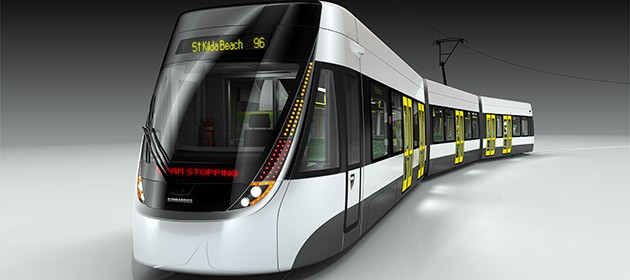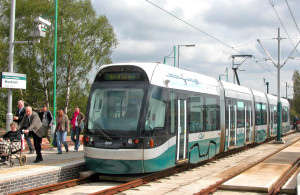Light Rail Vehicle (LRV) / Tram technology is highly evolved and widely implemented across the world. It is well-tested and suitable for implementation in a range of situations. Modern LRVs typically operate at maximum speeds of around 70-100 km/h, and employ regenerative braking technology to harness energy when brakes are applied, increasing energy efficiency.

LRVs and trams are essentially interchangeable, so in these pages we shall use the term ‘tram’. However, these modern vehicles should not be confused with the rickety old trams that once upon a time rattled along streets and were phased out as the private car assumed dominance! Times have changed and modern trams are very sophisticated, fast, smooth, practical, pleasant and comfortable.
Traditionally, trams are powered by electric overhead lines (catenary). However, some trams, such as Alstom’s Citadis X05, employ fast-charge batteries to power the vehicle so it can operate between stops without catenary, enabling protection of sites of high landscape or architectural value from visual intrusion. This can also reduce investment costs, help preserve trees along route, and enable better access for emergency services such as fire ladders in built-up areas. The technology charges on-board batteries within 20 s when the trams are at station stops. Birmingham trams are presently being converted to catenary-free. Very clever!
Trams are 100% electrically powered, so there are no carbon or other pollutant emissions at the street, resulting in improved inner city air quality. Potentially, if the LRV power source is from a sustainable supply, trams have zero CO2 emissions. Even if diesel buses employed today were replaced by electric, these typically hybrid vehicles may still emit pollutants at the street.

Modern trams are designed to be highly accessible for the elderly and the disabled. Low-level floors and wide doors enable easy access from the platform or street. These are important considerations in the UK, as we are living to an older age. With double doors, the passenger exchange rate is much easier and faster than on buses, which also reduces stop-time required at stations thereby increasing the overall speed of journeys.
A wide range of tram configuration is possible, from around 20 m to over 40 m in length, and accommodating from ~100 to over 300 passengers per tram. There is a trend towards smaller trams as an alternative to busways for medium sized cities, and compact trams have been adopted in cities such as Avignon and Aubagne. The City of Avignon has implemented a single-line network of 6 km with 10 stops. With a population of around 95 000 and classified as a World Heritage Site by UNESCO, Avignon may represent an interesting model for study.
It is worth remarking that Light Rail technology is fast-evolving, and even more technologically advanced vehicles are likely to be available by the time Cambridge Light Rail might become operational (…2025…?!). For example, driverless vehicles – much heralded as the ‘next big thing’ for our roads – are already in operation on London Docklands Light Railway, and elsewhere. Sophisticated control systems ensure the network operates smoothly, quickly, reliably and safely. It seems plausible that driverless systems, and innovative catenary-free Light Rail vehicles, might be standard by 2025.







